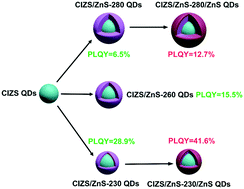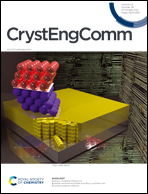Controlled synthesis of luminescent CIZS/ZnS/ZnS core/shell/shell nanoheterostructures†
Abstract
Cu-Based quantum dots (QDs) are of great interest due to their unique properties enabling the replacement of traditional toxic Cd- or Pb-based QDs, for use in bioimaging and biomedical applications. Different reaction conditions have profound effects upon the morphologies and photophysical properties of the obtained QDs, the investigation of which is crucial in order to prepare the highest quality Cu-based QDs. Here, we have carried out a series of studies, optimizing the synthesis of CIZS/ZnS/ZnS QDs via careful control of the ZnS shell deposition. The effects of different reaction temperatures and growth times on the resulting morphologies and optical properties of the QDs have been systematically examined. It has been found that reaction temperature plays a significant role in the resulting optical properties and morphologies, affecting the deposition dynamics of the shell materials and the onset of severe surface ligand degradation. Based on the detailed studies, optimal reaction conditions have been chosen and highly fluorescent CIZS/ZnS/ZnS core/shell/shell heterostructured QDs, with PLQYs as high as 41.6 ± 4.2%, have been produced. In addition, we have achieved for the first time a “giant” ZnS shell (QDs of 13.02 nm in diameter). These results are important for the further development of CIZS/ZnS/ZnS core/shell/shell nanoheterostructures with optimal optical properties and morphology.

- This article is part of the themed collections: Editor’s Collection: Advances in nanocrystal heterojunctions and Nanomaterials


 Please wait while we load your content...
Please wait while we load your content...